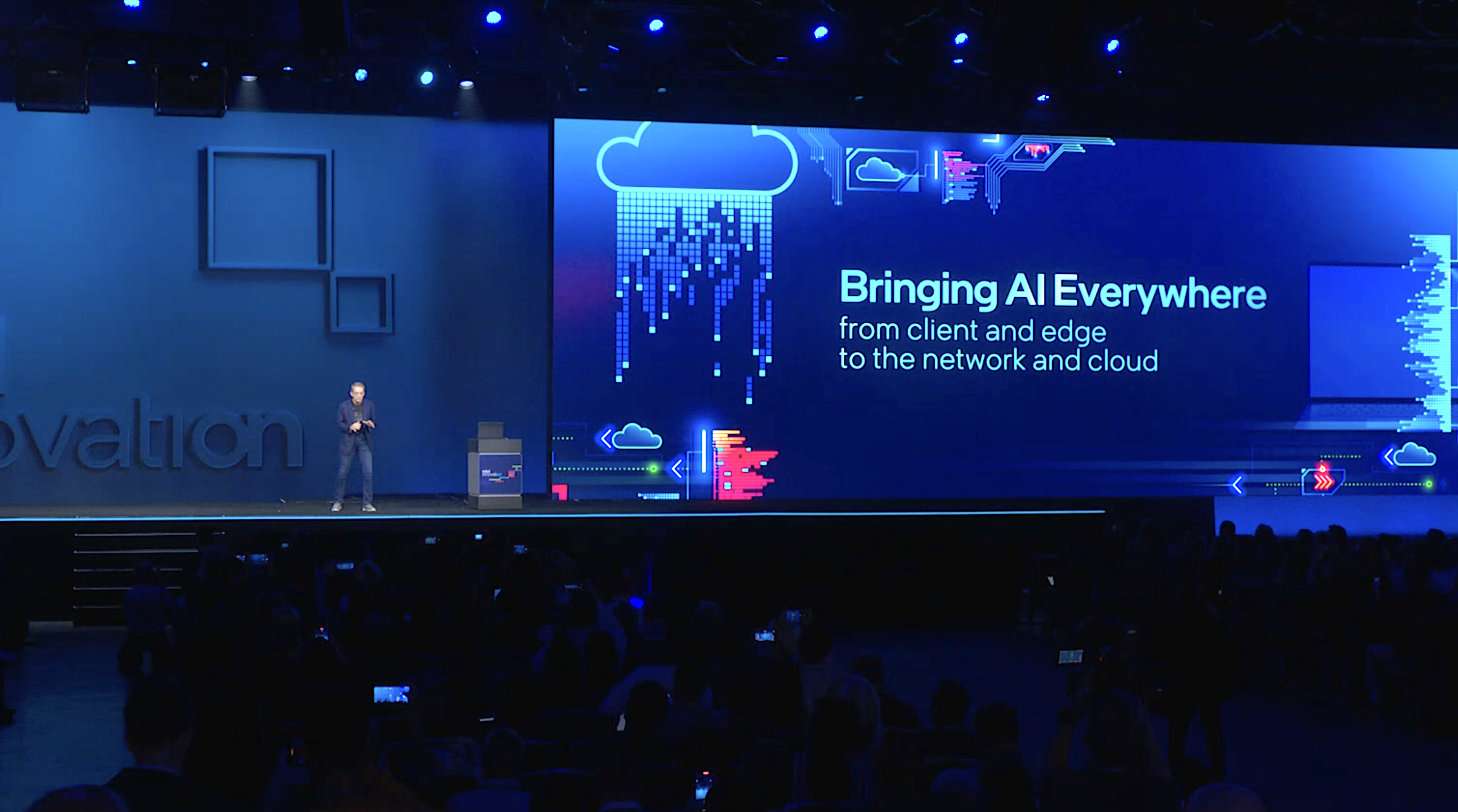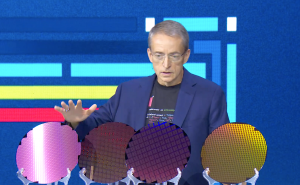 AI
AI
 AI
AI
 AI
AI
Hosting its third annual Intel Innovation event today, Intel Corp. took the opportunity to announce an array of new silicon platforms that it says will support artificial intelligence in every location, making it accessible across client devices, the edge and the cloud.
Intel Chief Executive Pat Gelsinger (pictured) took to the stage, and during his keynote address he spoke about how Intel is making AI accessible through a new generation of open, multi-architecture solutions. “The execution machine is back at Intel,” Gelsinger told the audience in San Jose.
The headline announcement today was an update on Intel’s five-nodes-in-four-years process. Gelsinger explained that the Intel 7 chips are already in high-volume manufacturing, with Intel 4 chips now “manufacturing-ready” and Intel 3 on track to reach the same status by the year’s end.
More specifically, Gelsinger announced Intel’s Sierra Forest Xeon processor with 288 cores, double the amount of the previously announced Sierra Forest processors and due to come to market in the future. Intel also announced that its fifth-generation Emerald Rapids Xeon will debut Dec. 14.
 Gelsinger showcased an Intel 20A wafer and the first test chips based on its Arrow Lake processor design, which will power the client computing market from 2024, he said. They’re the first processors from Intel to integrate Intel’s backside power delivery technology, called PowerVia, he added. They also boast new materials and packaging technologies such as glass substrates, which were announced Monday. “It’s not just about prototypes, it’s about volume, baby,” he said today.
Gelsinger showcased an Intel 20A wafer and the first test chips based on its Arrow Lake processor design, which will power the client computing market from 2024, he said. They’re the first processors from Intel to integrate Intel’s backside power delivery technology, called PowerVia, he added. They also boast new materials and packaging technologies such as glass substrates, which were announced Monday. “It’s not just about prototypes, it’s about volume, baby,” he said today.
In addition, Gelsinger held up a test chip package featuring Universal Chiplet Interconnect Express technology built by Synopsys Inc. It’s a new UCIe standard that enables chips from different vendors to work together as one, much bigger processor, in order to cater to complex AI workloads. The chip was built using Intel’s most advanced Intel 3 process and fabricated on a three-nanometer process node at Taiwan Semiconductor Manufacturing Co. Intel said the demonstration highlights the commitment to open standards by the world’s leading chipmaking firms.
On the product front, Intel said it’s developing a new AI supercomputer platform based entirely on its own technology. It will combine thousands of Intel Xeon central processing units with 4,000 Intel Gaudi2 AI hardware accelerators, and Stability AI Ltd. was announced as its flagship customer.
The Intel Gaudi2 chips are a big deal, with recent results from MLCommons’ MLPerf benchmark tests demonstrating that the hardware provides a viable and really the only alternative to Nvidia Corp.’s graphics processing units. Gelsinger said the Gaudi2 accelerators can power every aspect of AI, including training and inference on some of the largest large language models.
One of the first cloud platforms to offer access to Intel’s AI supercomputer will be Alibaba Cloud. It said it’s applying Intel’s Xeon processors with built-in AI acceleration to power its Tongyi Foundation Models, and has seen “remarkable improvements in response times, averaging three-times acceleration.”
Intel’s AI supercomputer will be equipped with the next generation of Xeon CPUs. The 5th Gen Intel Xeon chips promise some significant performance improvements, Intel said. There will be two options available when they launch, with Sierra Forest focused on efficiency set to launch on December 14, and the Granite Rapids chips, focused on performance, expected to become available early next year.
Another new product that will launch in December will make AI a much more personal affair, Gelsinger promised. He announced the new Intel Core Ultra processors codenamed Meteor Lake, which are designed for client devices such as laptops. They’re the first to feature Intel’s integrated neural processing unit, or NPU, designed for power-efficient local AI acceleration and inference.
“AI will fundamentally transform, reshape and restructure the PC experience – unleashing personal productivity and creativity through the power of the cloud and PC working together,” Gelsinger said. “We are ushering in a new age of the AI PC.”
Intel Core Ultra is also the company’s first client processor to use Foveros packaging technology, and is based on the advanced Intel 4 process. Gelsinger highlighted a range of use cases on stage.
Holger Mueller of Constellation Research Inc. said it’s encouraging to see that Intel appears to be emerging from a long winter, offering new platforms and capabilities, especially in terms of AI. “What’s most important, for customers, is that Intel now looks ready to begin mass-producing the next generation of silicon chips soon,” he said. “This will help to give Intel a stake in the AI supercomputer game, where its Gaudi2 hardware accelerators already look to be a strong offering.”
In order to help developers harness the most advanced AI technologies, Intel announced a new offering called the Intel Developer Cloud, which provides access to its most advanced software and hardware for AI development.
Through the Developer Cloud, developers an access the Intel Gaudi2 chips for deep learning, as well as the latest Xeon and GPU Max Series 1100 and 1550 processors. It provides an environment for developers to build, test and optimize AI applications, run small to large AI training, optimize their models and run inference with high performance and superior efficiency, Intel said.
What’s more, Intel Developer Cloud is built on an open foundation with oneAPI, a multi-architecture, multi-vendor programming model, that allows developers to access the cloud-based compute hardware of their choice.
In terms of software, Intel Developer Cloud provides access to the latest version of the OpenVINO toolkit, which is Intel’s favored AI inference and deployment runtime platform. It also incorporates Project Strata, which provides a horizontal approach to scaling the infrastructure required to run AI at the network edge.
Mueller said the Developer Cloud will be key to Intel’s plans to create an ecosystem around its new AI supercomputer platform. “Intel needs this to get developers on board,” he explained. “Assuming Intel can get all of these things right, it spells good news for everyone involved, including customers, investors and employees.”
With reporting from Robert Hof
THANK YOU